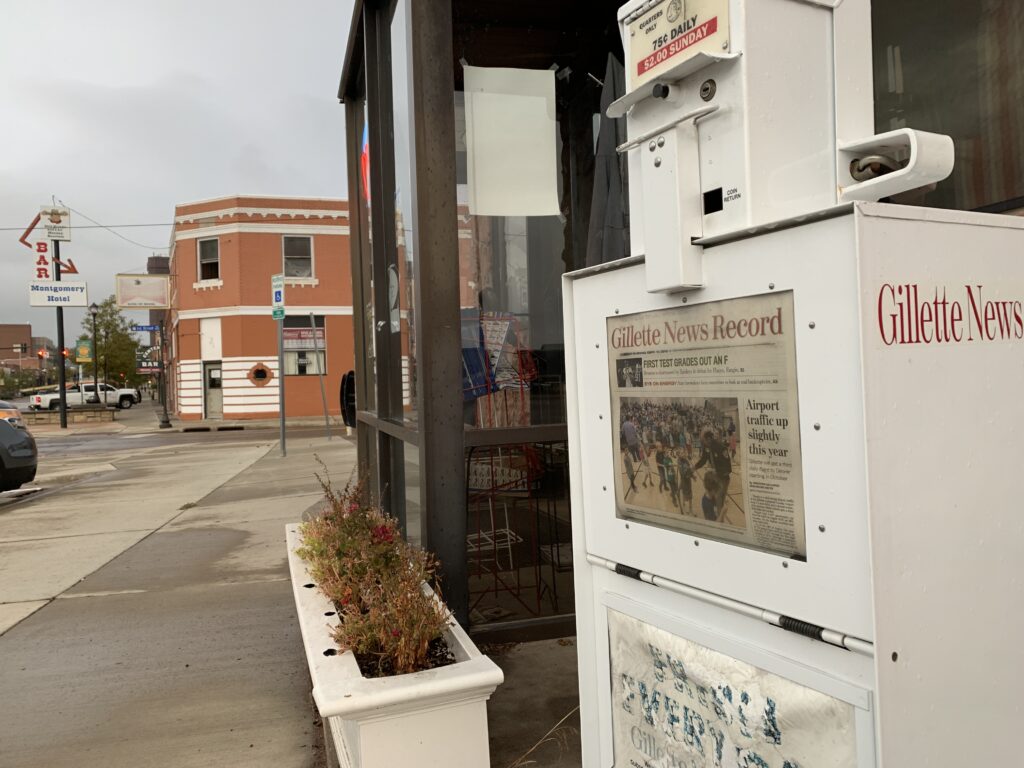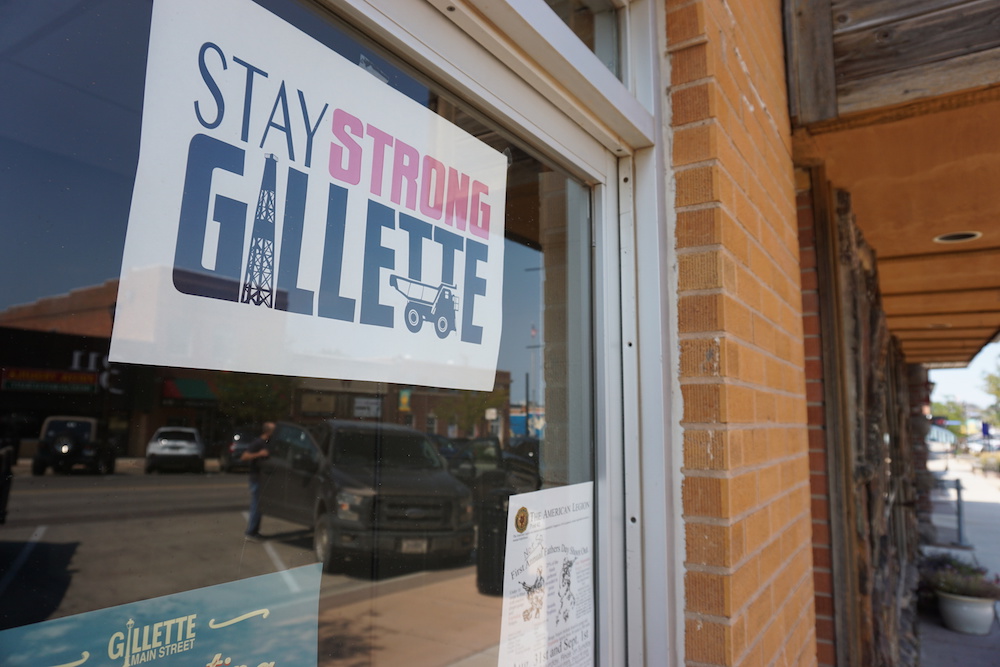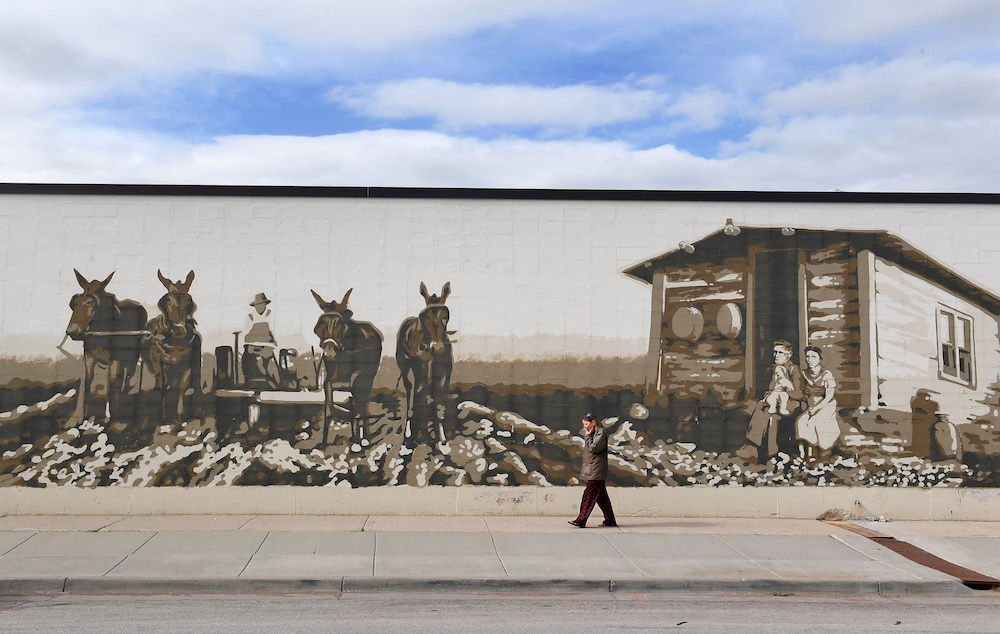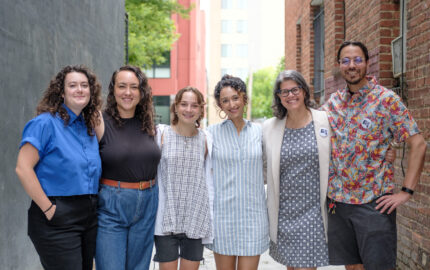The day in August 2005 when I idled into Gillette, Wyoming, began a years-long education in public trust in journalism.
That day, a curious neighbor stepped out of his townhome to the edge of the cul-de-sac adjacent our new home, waved, and waited as I nosed a burly moving truck into our one-car driveway.
A first chat with a new neighbor in 2005 was just another bump in the middle of a long downslide in Americans’ confidence in journalists
He and two of his children plodded across the concrete square that bordered our lawn and greeted my wife, Kate, and me as we unfolded ourselves after an 1,100-mile road trip. The short conversation that ensued would become a familiar recitation during the next eight years while I worked for the town’s family-owned, daily newspaper, the Gillette News Record.
The man, like many of our new neighbors, worked at an area coal mine. In those days, Gillette was ripe with blue-collar jobs that paid near six-figure wages. The mines were many people’s ticket to a middle-class life. And the town was in the midst of an energy boom that for years would inhale workers from across the country. Nobody I knew moved to Gillette for anything but work, and few left even as the market for coal began to soften in 2013.
Within minutes of our arrival, our new neighbor asked the one question that surely would provide common ground: What jobs lured us halfway across the country from Michigan to live in the bustling high-plains community?
Kate told him she was a teacher and would be looking for a job. He smiled, told her teachers are underpaid and do important work.
I told him I would start work at the newspaper the next week. His demeanor changed a little. I can’t recall the exact conversation trajectory that followed, but it’s one familiar to many journalists who work in local news. He said something about his problems with “the Media” but quickly adjusted his position to exclude me and the local newspaper from his quip.
I came to expect similar adjustments as I took up a camera and began shooting photos for the newspaper. During the next eight years, first as a photographer and later as a writer, thousands of sources welcomed me into their homes or trusted me in vulnerable moments. Many struggled to trust national news sources and voiced their qualms, but accepted local journalists as agents of truth.
Today a similar introduction may not carry the same civility or pleasant resolution. A first chat with a new neighbor in 2005 was just another bump in the middle of a long downslide in Americans’ confidence in journalists.
That slide wasn’t unique to Wyoming. A study conducted by Gallup found that between 1976 and 2016 public trust in media dropped by more than half, from 72 percent to 32 percent. Both anecdotal evidence and polling suggest the trust deficit has been more pronounced in Wyoming and other states in the country’s midsection.
That trust rating rebounded some during the past three years, but lingers at 41 percent today, more than 31 percent lower than the high mark set in 1976—four years after the Watergate scandal. A 2018 poll ranked newspapers and television news among the four major institutions in the United States with the least trust capital, just above Congress.
Polling numbers published by Gallup suggest the rebound following that bottom in 2016 was carried mostly by a rise in Democrats’ confidence in journalists. Anecdotes from on the ground in Gillette and the surrounding Campbell County—where 88 percent of voters cast ballots in support of Donald Trump in the 2016 election—suggest trust, at least in national news, hasn’t lifted much.
Worse, there is plenty of evidence the erosion of trust in national media manifested in a more tenuous relationship between local journalists and their communities.
I left Gillette several years ago for an opportunity to help lead a local newspaper in Michigan. I lived that trust spiral. No local journalist needs pollsters and pundits to tell us Americans’ trust in news has eroded. It came on in subtle increments, like the rhythm of waves caressing the Lake Michigan shoreline a few blocks from my office.
First came the complaints about editorial cartoons. Then accusations of bias in wire content. Finally, threats to quit reading over letters to the editor. Each wave carried away a little more of the trust we stand upon when we speak truth to power.
I wanted to see for myself what changed during the past six years in the place where I wrought my first, most important trust relationships as a journalist. I took a few days in early September to visit Gillette and hear from people there how attitudes toward journalists who serve the community have changed. It proved a difficult experience.
Gillette is a life raft situated in an ocean of prairie grass and buttes that press apart the Black Hills to the east and the Big Horn Mountains to the west. The roads to and from the town of about 31,000 are long and sparsely traveled.

Passersby still nod and lift a pair of fingers from the steering wheel as they hum along the tarmac strips that form thin veins of traffic across the horizon-to-horizon high plains. It’s the kind of place where sneakers and baseball caps mingle with boots and cowboy hats at local pizzerias and microbreweries. Where people still smile and hold doors for one another at the coffee shop. Where groomed lawns and American flags flying from porches are signs of hard work, not affluence.
The city rises for work early every day. A string of vehicles parade south toward a chain of open-pit coal mines each morning before the sun cracks the eastern horizon. Fewer workers join that lineup today than a half decade ago; nonetheless, the nose-to-tail string of vehicles arrives like clockwork.
Fears of a bust haven’t come to fruition, although plenty of neighbors worry quietly about a slowdown as electric utilities shutter coal-fired power plants. For now, a flourishing oilfield nearby has smoothed fluctuations at the mines.
The place hasn’t changed much. A few new streets cut the prairie to connect neighborhoods that sprawled into the grassland during the last boom-fueled construction surge. New retail stores sprouted where fallow land once lingered. And the school board finally split one giant high school into two pretty big ones.
The newspaper was there to record each of those changes, and thousands more new passages in the community’s history—a mirror with memory. But both the mirror and the people it reflects have changed.
Local journalists live an embedded life where everything else mingles with work, intertwining the things we love. I once fielded criticism from a reader who spotted me mowing my lawn and decided to stop his car to let me know what he thought about a column I wrote for that day’s paper. Trust seems to accrue a little easier when chance meetings between journalists and sources are the norm—at the grocery store, the sidelines of a Saturday morning soccer game, or shoulder-to-shoulder at a bar.
Maybe that’s why it feels like readers, even in the midst of the trust slide, seemed to put a little more stock in local journalists’ work.
I found a Sunday edition of the News Record lingering Monday morning in boxes outside a downtown coffee shop as patrons inside browsed national headlines on their smartphones. I wasn’t surprised to bump into former Gillette mayor Edd Collins outside the cafe on his way to a regular coffee klatch. I often witnessed the group’s meetings during my years with the newspaper. I recognized him. He couldn’t have placed me if I was wearing a name badge.
I told him who I was, what I was doing, and asked how he felt about news, both local and national. He said national news outlets don’t understand his town and “hate us.” He had gripes with the local newspaper that have nothing to do with his feelings about outside journalists. His sentiments, unsurprising as they were, echoed voices I overheard the night before while eating dinner at a local microbrewery.
A half mile west, I found the newspaper’s editor and publisher Ann Turner inside the newspaper offices along Second Street. She typically can be found at her desk along the front edge of the newsroom from open to close every weekday. Calls and office visits before noon when the paper is put to bed will be succinct, factual, polite. Mondays aren’t quite as hectic as they once were, because she dropped a day of print last year. The News Record now publishes five days—Tuesday through Friday and Sunday. The staff hits “send” on a string of stories for the paper’s website each Monday, but the office bustle isn’t quite the same. Habit made me wait until a little before noon to stop by the newsroom.
The furniture hasn’t changed, including the desk I occupied for most of my eight years at the paper. But few of the faces are the same. Turner’s newspaper has for decades served as a second home, classroom, and proving ground for young journalists from across the country. Most stay only a few years on their way up or out of the industry.
She affectionately refers to my cohort as the “class of 2005.” Some still work in journalism; most do not. That combination of a wise, experienced local news editor and a flow of hard-running newsies trying to make their bones made the newspaper disproportionately strong for its size.
The News Record, for years, has been a repository for difficult-to-tell stories, both enterprise and investigations. Turner points to a project published several years ago when school officials dispatched press releases declaring local students were “safer than ever.” The release raised eyebrows in the newsroom, where both editors and reporters knew the narrative they received was untrue. A reporting project that followed exposed the district’s dismal security practices, triggered a community uproar and compelled district officials to fix a litany of security shortcomings.
I wondered aloud if the same effort would generate similar engagement and results today. Would readers trust their newspaper today as they did then?
Local journalists live an embedded life where everything else mingles with work, intertwining the things we love
Turner worries both about the impact of polarization and decreased engagement on behalf of readers. The problems local newspapers face aren’t easy to fix, and nobody seems to have the answers, she says. Accusations of “fake news” cut deep. “The first reaction is anger, second is self-defense—we don’t do that—and then I think we’re all baffled,” Turner says. “We’re baffled because it was a proud profession. We were the truth tellers, always.”
Despite a few notable incidents, most people I ran into in Gillette say they look to the local newspaper for trustworthy reporting, even if the truth sometimes is difficult to swallow. That context makes some of Turner’s experiences during the past few years harder to internalize.
The editor whose hand nudged my career in the right direction too many times to count, sounded defeated. She bemoaned venomous reader feedback that has become a familiar saw for many local newspaper editors. She wondered aloud about new ways to engage readers, something that might trigger her community to care just a little more about the big issues.
She retold an incident that could only be described as a harbinger for local journalism.
Early in the fall of 2017 a shaken high school sports reporter called Turner’s cellphone seeking guidance. It was a Friday night, and reporter Jason Kort was assigned to interview parents and fans in the stands at a local high school football game. It was a unique event, Gillette’s first crosstown rivalry match—a meeting precipitated following a divisive decision to split the city’s single massive high school.
Kort was little more than six months into his first full-time reporting job and was the beat reporter covering one of the two schools forged in the split. Kort says many parents he approached in the bleachers were unhappy about the drubbing their team was in the midst of receiving. Some gave comments, but refused to proffer their names. Others lobbed the one insult they knew would cut deep, especially for a young journalist doing his level best to document his new community.
Kort told Turner he had begun combing the bleachers for fan reactions, and was met by shouts of “fake news.” “He was trying to interview grandparents, in some cases, of players,” Turner says. “I don’t know if they were angry and didn’t want to talk, but what was their response? ‘Fake news.’”
Kort says he managed to pull together a short story that night, but not the one he intended to report. The newspaper didn’t address the hostility in print, and Kort said the experience changed how he approached sources. Kort says he left journalism about six months later, not because he didn’t enjoy the work, but because he needed a better paying job. Today, the graduate of Hastings College works as a shipping manager for an ammunition factory in Arizona.
That kind of hostility toward local journalists covering a relatively innocuous subject is a far cry from the community I left behind six years ago. Sure, there were plenty of stories during my tenure that generated backlash, but angry flailing toward a sports reporter is beyond anything I could have imagined. And the editor who I often channeled when navigating difficult decisions in my own newsroom was baffled. Not mad. Worried.
So I wasn’t surprised early this year when the Society of Professional Journalists announced it would launch the first phase of its media trust and democracy project in Casper, Wyoming. SPJ leaders cited Gallup’s findings that people in Wyoming trust the media slightly less than in other states. SPJ Journalist on Call Rod Hicks led the project, a series of meetings spread across six months aimed to give residents a more intimate understanding of how both national and local journalists work. Hicks says he hoped to send participants away with a more complete understanding of how news-gathering works and how to identify sound, ethical reporting. He also hoped to walk away with a more definitive picture of how readers see journalists and what they may need from us to rebuild trust.
Casper is a two-hour drive southwest from Gillette. Casper is a little bigger, but the cities have a similar demographic and political breakdown. The results outlined in the 32-page report generated by Hicks’ effort echoed the tension I felt while visiting Gillette.
Conservative-leaning participants voiced substantial issues with how national outlets cover President Donald Trump. Most of that coverage in local outlets occurred in the form of wire stories from the Associated Press. I’ve seen slips in how the AP differentiates between analysis and straight news cause an uproar from readers in my own community. The focus on such a small piece of local news outlets’ work probably would recur in any mid-American town. I’ve fielded similar complaints in the northern Michigan community where I now lead a newsroom. And I’ve heard from peers and readers across the country who echo similar experiences.

No local newsroom leader has enough time to scour every inch of every wire story, and those instances where opinions occasionally pepper pages meant for facts cost us all dearly.
Fielding reader complaints about perceived bias in AP stories has become an extra duty for local newspaper editors and publishers. The gripes usually cite disparities in tone or semantics in coverage of Trump when compared to previous presidents or current Democratic presidential candidates. The first such gripes I recall receiving were in 2016 when a few readers compared wire service coverage of the Republican and Democratic national conventions. I raised the issue with an AP regional editor who in short order discarded the concern. Since then, I have heard many of my peers who run newsrooms across the Midwest and mountain states recount similar issues.
A spokesperson for the AP who responded to questions about 2016 convention coverage did not address specific questions related to the previous reporting, but she says, “Each story [at the AP] is held to the same standards: accurate, unbiased, factual reporting."
Noreen Gillespie, the AP’s deputy managing editor for U.S. news, wasn’t in her current role during the last election. She says the AP’s standards editor reviews feedback from members and readers on an ongoing basis, and that process sometimes leads to changes in word usage or headlines on the fly during a news cycle.
Additionally, she says the organization launched a new initiative for the ongoing impeachment process that solicits real-time feedback from member newsrooms. “I want us to be as close to the editors who are hearing that feedback as possible,” she says.
“If they are seeing things, or if they are hearing things that got an interesting reaction, a positive reaction, a negative reaction, that’s feedback we really want to have.”
Nobody is closer to that feedback than local journalists, who field calls and reader comments on everything that appears in the local news flow, from wire stories to lottery numbers.
Tom Lubnau II is one of those readers who I learned long ago pays close attention to that line between fact and opinion in news. He didn’t hesitate to set aside time to talk with me when he heard I was headed to town.
Lubnau was speaker of the Wyoming House of Representatives from 2013 to 2015, the capstone to a decade in office. During my years working in Gillette, I became accustomed to seeing Lubnau in court—he’s a lawyer by trade—at the legislature or rumbling around fire and crash scenes during his shifts as a volunteer firefighter.
He was raised in Gillette and chose to stay put to raise his own children. He said people in his community still rely upon and trust the newspaper and other local news outlets more than national sources because of their face-to-face relationship with their community journalists. “I think the local journalists they trust, because it’s a trust and verify situation,” he says. “The national news media is a little problematic because the country has become a sort of Tower of Babel where you can pick your news sources.” Lubnau’s feelings echo a 2018 Poynter survey that indicated news consumers’ trust in local TV and newspapers has persisted at much healthier levels than trust in national outlets.
Across the political spectrum 76 percent of people said they have “a great deal" or "a fair amount" of trust in local TV news. Seventy-three percent responded with the same confidence in local newspapers. It’s as much as 18 percentage points higher than similar responses for national TV news and national newspapers.
Local news outlets are feeling the negative impacts of a trust battle waged far from their doorsteps over reporting they had no hand in producing. Heck, it feels like the majority of complaints we field about blurring lines between opinion and news originate with the melange of commentary and fact stirred together 24 hours a day by cable TV networks. Readers who have a superficial-at-best understanding of how journalists work take cues from propaganda-laden social media feeds and politicians—including our president—who paint journalists as sloppy purveyors of untruths.
I left some of my conversations in Gillette frustrated. Others gave me hope. It’s clear being a good journalist and caring about the communities we serve isn’t enough anymore. I reached out to the one person I know who specializes in helping newsrooms build and maintain trust in their communities.
Joy Mayer, director and founder of Trusting News, contends that deflecting responsibility for the trust deficit in local news onto the back of a national problem with polarization is a little too easy.
But there are plenty of opportunities for local journalists to build trust in their communities. When asked about trusting journalists, people often answer only based on their feelings about national media, unless prompted to talk about their local outlets, Mayer says. She has worked in audience engagement for nearly a decade and provides training and advice to local journalists in newsrooms across the country. “It just seems to me people feel less connected to local news than they used to be,” she says.
It’s clear being a good journalist and caring about the communities we serve isn’t enough anymore
Counteracting that narrative and the broader lack of understanding of how local news-gathering works is a matter of education and can build trust in local news even in the face of faltering public opinion on national news credibility, she says: “When we are not telling the story of what we do, people are not giving us the benefit of the doubt. We’re not telling the story of our values and the breadth of what we cover, and our ethical policies and our goals and our mission. People assume the worst.”
Trusting News, SPJ, and many other organizations have begun working in recent years on reader outreach. Those attempts to help news consumers better understand how journalists work don’t always result in an immediate pivot in public opinion—see the Casper Project’s full report—but they are an important move toward demystifying how news, both local and national, works.
Gary Beerline sat reading a copy of the News Record at a table in the back corner of Lula Belle’s Cafe the final morning of my short September visit. I decided to eat breakfast at the historic, cinder-block cafe because I hadn’t been there in several years.
Sarina Sturtz still cuts her way through the tiny dining room, taking orders, topping-off coffee cups, and shuttling food from the kitchen window to tables. Laurie Calvert, one of the cafe’s owners, chips away at orders on the flat-top griddle. And many of the same characters saunter in for a bite to eat and a little chatter with friends before work.
The conversations are the same—rain near Rozet the night before, moving cattle, where the oil field work is up or down, and a bit of politics peppered between.
Beerline, 60, works in a nearby coal mine and enjoys grabbing a local newspaper to read at breakfast on his days off. He says he watches CNN and Fox News or reads online publications most days, but has trouble trusting national reporting. The News Record is different; he trusts it, trusts the local journalists who work there, he says: “If I was retired, I’d read it every morning or every night.”
Trust in news has suffered during the past several years, including in local outlets, but readers like Beerline provide important perspective and hope for local journalists. They are readers who value and trust the proximity provided by local news. They are readers who still take care to differentiate between local journalists and “the Media.”
At a time of unprecedented polarization and partisanship, Nieman Reports is publishing a series of articles exploring how the crisis in local journalism is impacting communities in the run-up to the 2020 presidential election. Read all of the articles in the Election ’20: The Role of Local News series here.



